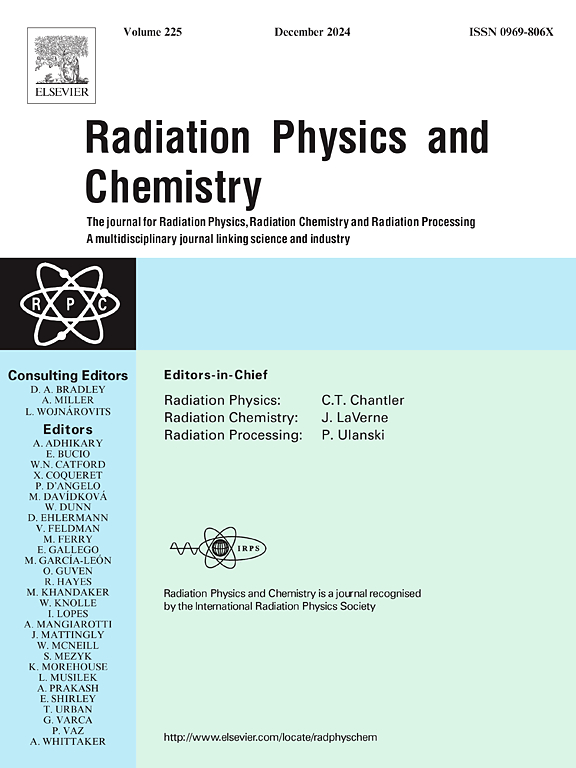基于FLUKA和GEANT4的CaSO4:Dy Teflon嵌入热释光剂量计徽章对光子和β源不同ISO模态的响应
IF 2.8
3区 物理与天体物理
Q3 CHEMISTRY, PHYSICAL
引用次数: 0
摘要
本研究采用蒙特卡罗编码FLUKA和GEANT4对CaSO4:Dy Teflon圆盘TLD徽章响应的角度变化进行了评价。这些徽章被放置在不同的ISO模型上,以模拟能量范围为12.3 keV至1.25 MeV的光子,以及90Sr/90Y和106Rh/106Ru β源的0°至60°的角度曝光。在ISO平板、圆柱形和柱状幻影中,分别得到了光盘TL响应的Hp(10)、Hp(3)和Hp(0.07)随光子能量的函数图。此外,研究估计了圆盘比(R12和R32)在光子和β能量方面的响应角变化。模拟结果表明,当x射线能量较低时,开放盘(D3)的响应更高,这是由于光电效应的增加。相反,观察到金属滤光片(D1)下光盘的响应随着角度的增加而增加,表明来自盒体和模体的康普顿散射,特别是在较低的x射线能量下。对于90Sr/90Y和106Rh/106Ru两种β源,D2盘(PMMA滤波器下)和D3盘的β响应随入射角减小,而R32比随入射角增大。值得注意的是,模拟结果与实验结果吻合较好,增强了蒙特卡罗模拟在不同辐照条件下TLD徽章复杂相互作用和响应的可靠性。本文章由计算机程序翻译,如有差异,请以英文原文为准。
Response of CaSO4:Dy Teflon embedded thermoluminescent dosimeter badge on different ISO phantoms for photons and beta sources using FLUKA and GEANT4
In this study, Monte Carlo codes FLUKA and GEANT4 were used to assess the angular variation in the response of CaSO4:Dy Teflon disc based TLD badge. These badges were positioned on various ISO phantoms to simulate the angular exposures ranging from 0° to 60° for photons within the energy range of 12.3 keV to 1.25 MeV, as well as for 90 Sr/90 Y and 106 Rh/106 Ru beta sources. Plots showing the TL response of the discs in terms of H p (10), H p (3), and H p (0.07) as a function of photon energy were obtained for ISO slab, cylindrical, and pillar phantoms, respectively. Additionally, the study estimated the angular variation in the response of disc ratios (R12 and R32) with respect to both photon and beta energies. The simulation results revealed that the response of the open disc (D3) was higher for lower X-ray energies, attributed to an increase in the photoelectric effect. Conversely, the response of the disc under the metal filter (D1) was observed to increase with the angle, indicating the Compton scattering from the cassette body and phantom, especially at lower X-ray energies. Beta response of both disc D2 (under PMMA filter) and D3 found to be decreasing with the angle of incidence while R32 ratio found to be increasing with the angle of incidence for both 90 Sr/90 Y and 106 Rh/106 Ru beta sources. Notably, the simulated results demonstrated good agreement with experimental observations, reinforcing the reliability of the Monte Carlo simulations for complex interactions and responses of TLD badges under different irradiation conditions.
求助全文
通过发布文献求助,成功后即可免费获取论文全文。
去求助
来源期刊

Radiation Physics and Chemistry
化学-核科学技术
CiteScore
5.60
自引率
17.20%
发文量
574
审稿时长
12 weeks
期刊介绍:
Radiation Physics and Chemistry is a multidisciplinary journal that provides a medium for publication of substantial and original papers, reviews, and short communications which focus on research and developments involving ionizing radiation in radiation physics, radiation chemistry and radiation processing.
The journal aims to publish papers with significance to an international audience, containing substantial novelty and scientific impact. The Editors reserve the rights to reject, with or without external review, papers that do not meet these criteria. This could include papers that are very similar to previous publications, only with changed target substrates, employed materials, analyzed sites and experimental methods, report results without presenting new insights and/or hypothesis testing, or do not focus on the radiation effects.
 求助内容:
求助内容: 应助结果提醒方式:
应助结果提醒方式:


